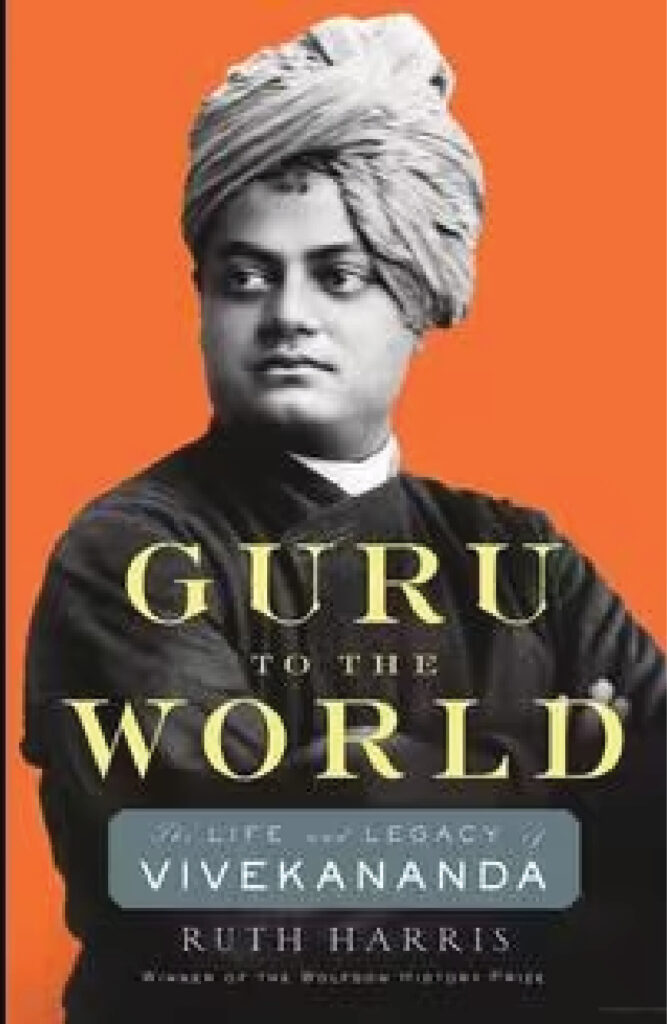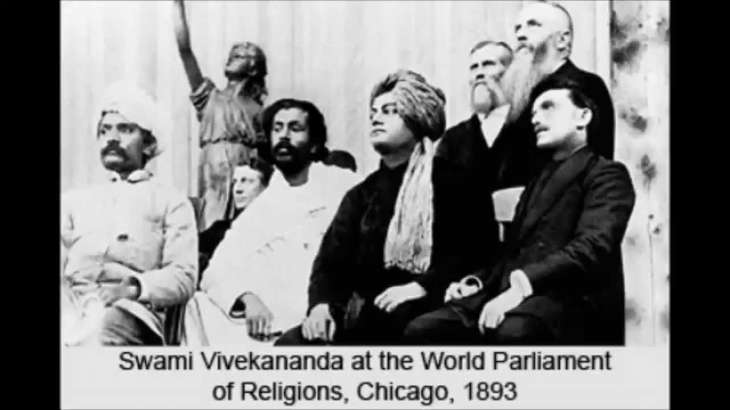The brilliant young man, with his easy command of eastern and western religions became a sensation across America during the four years he spent there.
130 years ago, on 11 September 1893, a 30-year-old in ochre robes from a subjugated nation electrified a gathering at the World’s Parliament of Religions in Chicago with his message of universal acceptance (not mere tolerance). Quoting from the Bhagavad Gita (“Whosoever comes to Me, through whatsoever form, I reach him; all men are struggling through paths which in the end lead to me”), he thus ‘contrasted the capacious universality of Hinduism with the emphasis on sectarian exclusivity in the Gospel of John (John 14:6), which states that “no one comes to the Father except through me”.’
Swami Vivekananda, the young monk from British-occupied India, had thus neatly subverted the Parliament’s goal of demonstrating ‘that there is no teacher to be compared with Christ, and no Saviour except Christ’, to quote the chair of its organizing committee, Reverend John Henry Barrows of Yale’s Divinity School. The biographer Ruth Harris admits that the main lay organizer, Charles Bonney also ‘did not believe that all “religions were of equal merit”,’ but held that ‘all men received a “universal influx from God” into their souls’—which provided enough leeway for speakers from Japan, India and Sri Lanka to make the case forcefully for other faiths.
But Vivekananda’s stirring message of universal love and India’s millennia-long history of welcoming adherents of every persecuted religion (including Jews and Parsis) soon made him the star of the World’s Parliament. He confronted the very concept of “original sin” that is central to Christian theology, telling his rapt audience that “the Hindu refuses to call you sinners. Ye are the Children of God, the sharers of immortal bliss….[to call humans sinners] is a standing libel on human nature”. He explained that the Vedas were a ‘revelation that had no “beginning or end”…an “accumulated treasury of spiritual laws”…that would be added to and rearranged forever’ by men and women (rishis) who ‘would continue to discover them in new ages’. And he showed that the Vedic idea of creation without beginning or end was consistent with the conclusion of physics through thermodynamics.
Ruth Harris is a professor of European History at the University of Oxford, and she came to Sri Ramakrishna and Swamiji via reading Romain Rolland, the French litterateur who won the Nobel Prize for literature two years after Tagore. Hers is one of the finest biographies ever written by a Westerner about the spiritual founders of Renascent Hinduism. Unlike professors of Divinity (who belong to a tradition of scholarship aimed at privileging Christianity), Harris does not seek to judge Vivekananda but to understand him.
Her research into Sri Ramakrishna’s spiritual journey and message is meticulous. She bases this on an objective reading of Swami Saradananda’s Lilaprasanga (Divine Play) and later Mahendranath Gupta’s Kathamrita (The Gospel of Sri Ramakrishna). She sensitively deals with his immersion in the Vaishnava bhakti tradition of Sri Chaitanya, the tantric roots of Kali worship, and the bliss of Advaitic realization. And she delves briefly into how Sri Ramakrishna “entered into Islam” (primarily its Sufi version) to ‘experience its mystical possibilities with the same gusto’, and the spiritual bliss he experienced at the culmination of his three days meditating on Christ. She beautifully evokes Sri Ramakrishna’s childlike yet ascetic personality, and his remarkable ability to convey deep spiritual messages with simple parables, aphorisms and song.
In the mid-19th century, Bengali elites had responded to the challenge of the new imperial power mainly via the Brahmo Samaj, which incorporated many elements of Christian rationality (and some Islamic influences) onto a reading of the Upanishads shorn of idols and rituals. The young Narendranath Datta too became a Brahmo during his college years, as did many educated Indians in that period. But his spiritual quest somehow remained unfulfilled, until he almost accidentally visited the mystic of Dakshineswar, Sri Ramakrishna, whose spiritual ecstasies had been mentioned by his college professor, Rev. William Hastie, while trying to explain Wordsworth and Shelley.

The rationalist in Narendranath was sceptical of the mystic of Dakshineswar after the first visit, although he felt an ephemeral mystical attraction that drew him back. By then Sri Ramakrishna was highly evolved spiritually, having spent a quarter-century as the priest of the Kali temple established by a Shudra widow, Rani Rashmoni, breaking down barriers of caste, gender and other fetters as he attained astonishing heights of spiritual realization through myriad paths. To Narendra’s question “have you seen god?”, Sri Ramakrishna readily answered that he had, and quickly gave the young man a glimpse of the vast spiritual possibilities of what he meant.
And thus began the association between seeming opposites—the rationalist, widely-read Vivekananda and his spiritual master, the near-illiterate but spiritually-evolved Sri Ramakrishna with his experiential comprehension of the capacious forms of Hindu worship. Harris likens the relationship to that between Christ and his great disciple Paul, particularly the follower’s role in interpreting the seemingly eccentric teaching of the master to a wider audience in the western world. Chicago was the window through which Vivekananda took his master’s word to the West.
The brilliant young man, with his easy command of eastern and western religions became a sensation across America during the four years he spent there, especially among intellectuals like the philosopher and psychologist William James and Harvard’s classics scholar John Henry Wright. The latter said Vivekananda was “more learned than all our learned professors put together”. Most of all, however, he was helped a group of wealthy women disciples—spiritual seekers Josephine McLeod, Mary Hale and her sisters, and Sarah Bull—who embraced his message and broadcast it widely during his lifetime.
Margaret Noble, who belonged to an Irish-nationalist family despite being Protestant, was to become the most important of Swamiji’s western disciples. She formally became a brahmacharini called Nivedita, experiencing the bliss of spiritual elevation at Amarnath in Swamiji’s company—while personally also feeling almost betrayed by his immersion in his own spirituality there.
The one slightly dissonant note is Harris’s interpretation of Nivedita’s Indian-nationalist turn after Swamiji’s samadhi (death) as being an expression of her personal independence. In reality, Swamiji is known to have written a poem for her in his last days, which enjoined upon her the responsibility of creating an Indian nationality. Nivedita distanced herself from the Ramakrishna Mission not because she sought autonomy from it, but precisely to protect it from the political fallout of her increasing support for the revolutionaries led by Sri Aurobindo, on whom she had a profound influence, just as she played a major role in enabling the scientist Jagadish Bose to gain acceptance (despite the innately racist resistance to his ideas) in the west. Nivedita remained close to (and deeply influenced by) Sarada Devi all her life, and is still deeply revered by the Ramakrishna Mission.
Vivekananda’s work Raja Yoga was his lasting legacy in the West, morphing later into Hatha Yoga (often stripped of its spiritual essence). But there was strong resistance among a determined group of Christian missionaries even during his lifetime, who sought to demonize Hinduism as a heathen and occult faith. Swamiji opposed magic and any elements of the occult, considering them inauthentic (including the work of Madame Blavatsky and the theosophists).
During his lifetime, and for the decade after it that Nivedita lived and worked in India and the west, Swamiji’s legacy was alive and thriving. But the Christian missionaries eventually got their way (once Josephine and Nivedita died in 1911), and they were able to ensure that the Swami’s name vanished into obscurity after 1915. In 1976, I was astonished that the 20-volume World Book encyclopaedia (America’s version of Britannica) didn’t contain Vivekananda’s name. In 1990, the World Treasury of Modern Religious Thought devoted just 3 of its 65 chapters to Hinduism—by Tagore, Gandhi and Radhakrishnan. Ruth Harris’ marvellous book needs to be read widely by Indians, but more importantly needs to spread widely worldwide, so that this remarkable savant becomes better known again as the true representative of Hinduism renascent.
Prasenjit K. Basu is the author of the prize-winning book Asia Reborn.

